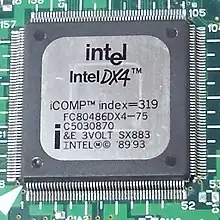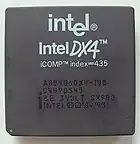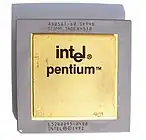iCOMP (index)
iCOMP for Intel Comparative Microprocessor Performance was an index published by Intel used to measure the relative performance of its microprocessors.
iCOMP=319
iCOMP = 435
iCOMP = 510
iComp = 815
iCOMP = 1000
iCOMP 2 = 100
iCOMP 2 = 111
iCOMP 2 = 114
Intel was motivated to create the iCOMP rating by research which showed that many computer buyers assumed that the clock speed – the “MHz” rating – was indicative of performance, regardless of the processor type. iCOMP ratings based on standard benchmarks.[1] The formula for calculating iCOMPs is like this:
| Category | Benchmark | Weight |
|---|---|---|
| 16-bit Integer | ZDbenchCPU | 52% |
| 16-bit Floating-Point | 16-bit Whetstone | 2% |
| ZDbenchCPU | 1% | |
| 16-bit Graphics | ZDbenchCPU* | 10% |
| 16-bit Video | ZDbenchCPU* | 5% |
| 32-bit Integer | SPECint92 | 15% |
| 32-bit Floating-Point | SPECfp92 | 5% |
| 32-bit Graphics | SPECint92* | 5% |
| 32-bit Video | SPECint92* | 5% |
The largest component is the integer CPU benchmark from Ziff-Davis Labs (ZDbenchCPU), which is derived from the earlier PC Labs benchmarks. Whetstone (as implemened in PowerMeter) is used for 16-bit floating-point, and SPECint92 and SPECfp92 are used for the 32-bit components.[1]
There were three revisions of the iCOMP index. Version 1.0 (1992) was benchmarked against the 486SX 25, while version 2.0 (1996) was benchmarked against the Pentium 120.[2] For Version 3.0 (1999) it was Pentium II at 350 MHz.[3]
See also
References
- Michael Slater (October 7, 1992). "Intel Unveils "iCOMP" Performance Index" (PDF). Microprocessor Report. Vol. 6, no. 13. MicroDesign Resources. Retrieved January 4, 2024.
- "iCOMP(R) Index 2.0". faculty.iima.ac.in. Archived from the original on 1996-12-20. Retrieved 2019-12-17.
- "Intel(r) Processor Performance Indicators". 1999-02-25. Archived from the original on 1999-02-25. Retrieved 2019-12-17.
- "IDEAS Top Performers - Intel iCOMP (Full List)". Ideas International. Archived from the original on January 16, 2006. Retrieved February 10, 2006.



.png.webp)
.JPG.webp)
.jpg.webp)
_P133_SY028.jpg.webp)
_(cropped)_A80502150_SY015.jpg.webp)